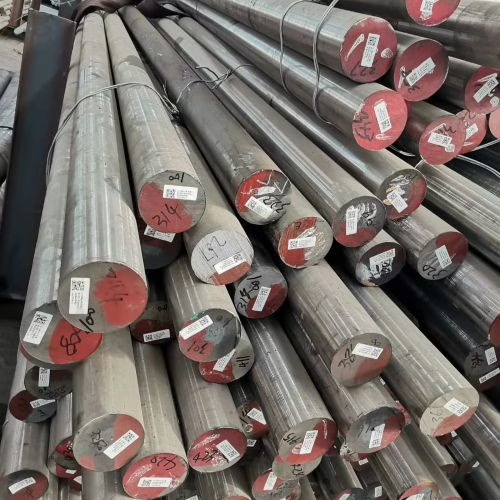Cr6WV Steel Technical Overview
Cr6WV Steel Technical Overview: Cr6WV is a medium-alloy cold work die steel offering reliable overall performance. Key characteristics include minimal deformation after hardening, good hardenability, effective wear resistance, and notable impact toughness.
Compared to Cr12 and Cr12MoV steels, Cr6WV has lower alloy and carbon content. This results in a more uniform carbide distribution, contributing to improved bending strength and impact toughness, especially when oil-quenched from 960°C.
Cr6WV is equivalent to the American A2 steel grade.

1. Cr6WV Steel Chemical Composition (Standard GB/T 1299-77)
The typical chemical composition of Cr6WV steel according to GB/T 1299-77 is as follows:
Chemical Composition (Weight Fraction) / % | Minimum | Maximum |
Carbon (C) | 1.00 | 1.15 |
Silicon (Si) | – | ≤0.40 |
Manganese (Mn) | – | ≤0.40 |
Chromium (Cr) | 5.50 | 7.00 |
Tungsten (W) | 1.10 | 1.50 |
Vanadium (V) | 0.50 | 0.70 |
Phosphorus (P) | – | ≤0.030 |
Sulfur (S) | – | ≤0.030 |
2. Cr6WV Steel Physical Properties
2.1 Critical Temperatures
Approximate critical point temperatures for Cr6WV are:
Critical Point | Temperature (Approximate Value) / °C |
Ac1 | 815 |
Accm | 845 |
Ar1 | 625 |
Arcm | 775 |
Ms | 150 |
Mf | -100 |
2.2 Linear Expansion Coefficient
Linear expansion coefficients (α) for different temperature ranges:
Temperature / °C | Linear Expansion Coefficient α / × 10⁻⁶ °C⁻¹ |
100 ~ 250 | 10.3 |
250 ~ 350 | 11.0 |
350 ~ 600 | 12.8 |
3. Cr6WV Steel Heat Treatment
3.1 Forging
Recommended forging parameters:
Item | Heating Temperature / °C | Starting Forging Temperature / °C | Ending Forging Temperature / °C | Cooling Method |
Steel Ingot | 1100 ~ 1160 | 1060 ~ 1120 | – | – |
Steel Billet | – | – | 850 ~ 900 | Slow cooling after forging |
Ensure slow cooling after forging.
3.2 Hardening and Tempering
Standard hardening involves oil quenching, typically from 960°C (though 950°C and 1010°C are used for reference tests). Consider slightly higher quenching temperatures for larger sections (approx. φ30-60mm).
Important: For large or complex parts, use preheating and slow heating to ensure uniformity and minimize the risk of cracking. Temper immediately after quenching to relieve stress.
The relationship between tempering temperature (2 hours) and resulting hardness (HRC) is shown below:
Tempering Temperature / °C | Hardness (HRC) after 950°C Quench | Hardness (HRC) after 1010°C Quench |
100 | 62 | 63.5 |
200 | 57.5 | 60 |
300 | 55 | 57 |
400 | 53.5 | 56 |
500 | 51 | 56 |
550 | 49 | 56 |
600 | 48 | 55.5 |
650 | 47 | 53 |
4. Cr6WV Steel Applications
Cr6WV steel’s balance of high strength, wear resistance, and toughness makes it suitable for various demanding applications:
- Gauge blocks and gauges
- Drill sleeves
- Punching dies and punches
- Cold heading dies
- Round rolling dies
- Trimming dies
- Stamping dies
- Thread rolling dies and plates
- Wear-resistant parts
- Integral molds
- Heavy-duty processing tools
For applications like drawing dies (stainless steel) or cold extrusion dies (aluminum, steel), a hardness of 62-64 HRC is often specified. It is also effective for high-volume cold stamping dies (over 1 million pieces) for thin low-carbon steel plates (<1mm).
In essence, Cr6WV provides a versatile and reliable solution for many cold work tooling requirements.
Explore Our Other Products
D2/1.2379/SKD11
D3/1.2080/SKD1
D6/1.2436/SKD2
A2/1.23663/SKD12
O1/1.2510/SKS3
O2/1.2842
S1/1.2550
S7/1.2355
DC53
H13/1.2344/SKD61
H11/1.2343/SKD6
H21/1.2581/SKD7
L6/1.2714/SKT4
M2/1.3343/SKH51
M35/1.3243/SKH55
M42/1.3247/SKH59
P20/1.2311
P20+Ni/1.2738
420/1.2083/2Cr13
422 stainless steel
52100 bearing steel
440C stainless steel
4140/42CrMo4/SCM440
4340/34CrNiMo6/1.6582
4130
5140/42Cr4/SCR440
SCM415
Cr6WV Tool Steel – Toughness & Heat Resistance You Can Rely On
✅ Direct from Aobo Steel Manufacturer – Get factory pricing with no middlemen
✅ Designed for High-Performance Dies & Tools – Excellent strength, wear, and heat resistance
✅ Custom Size Cutting Available – Supplied to your exact specs to save time and cost
✅ Fast International Shipping – Export-ready packaging with reliable logistics
✅ Bulk Order Discounts – Special pricing for large volume purchases
✅ Free Expert Consultation – Get advice on hardness, heat treatment, and usage
